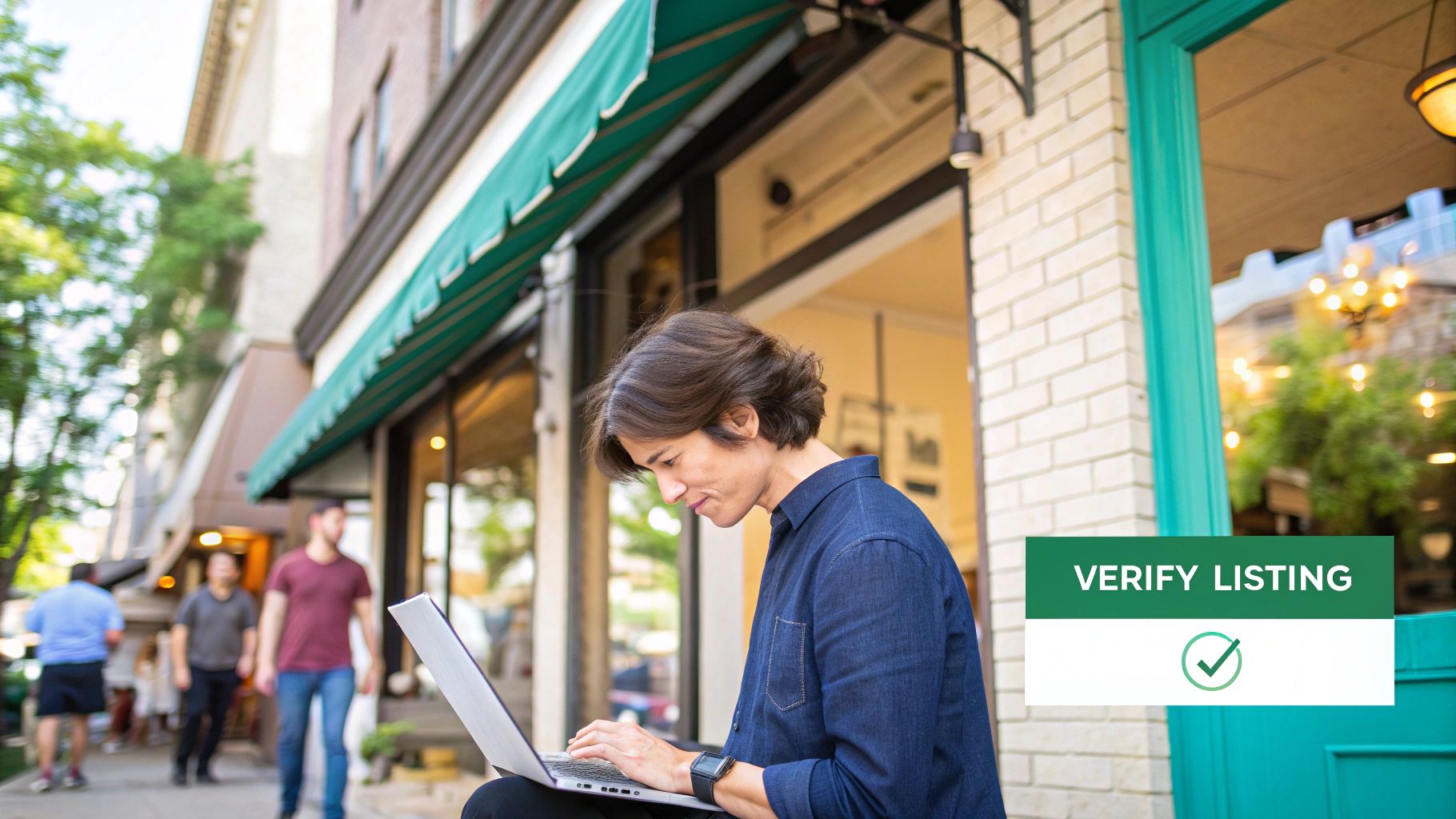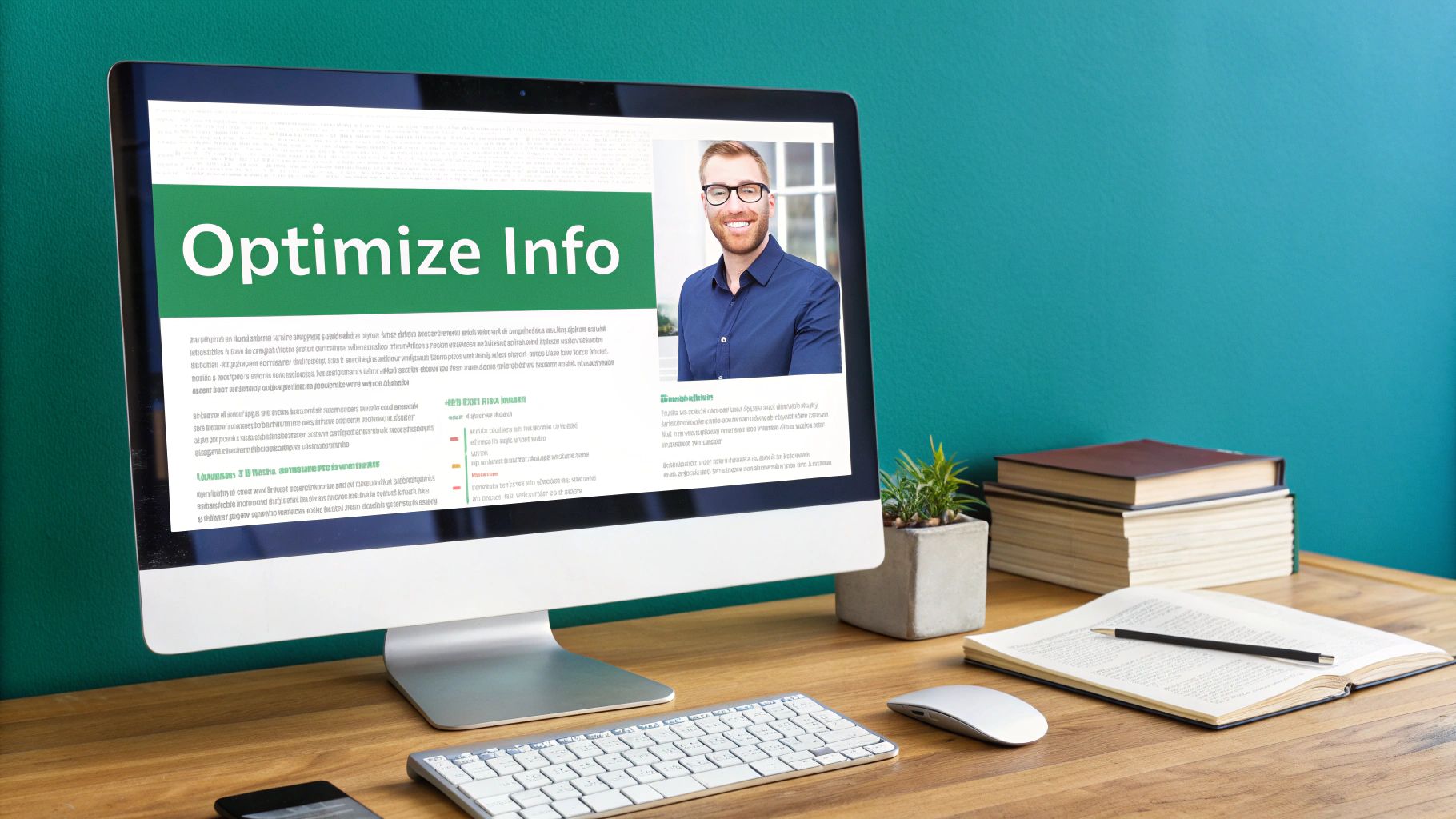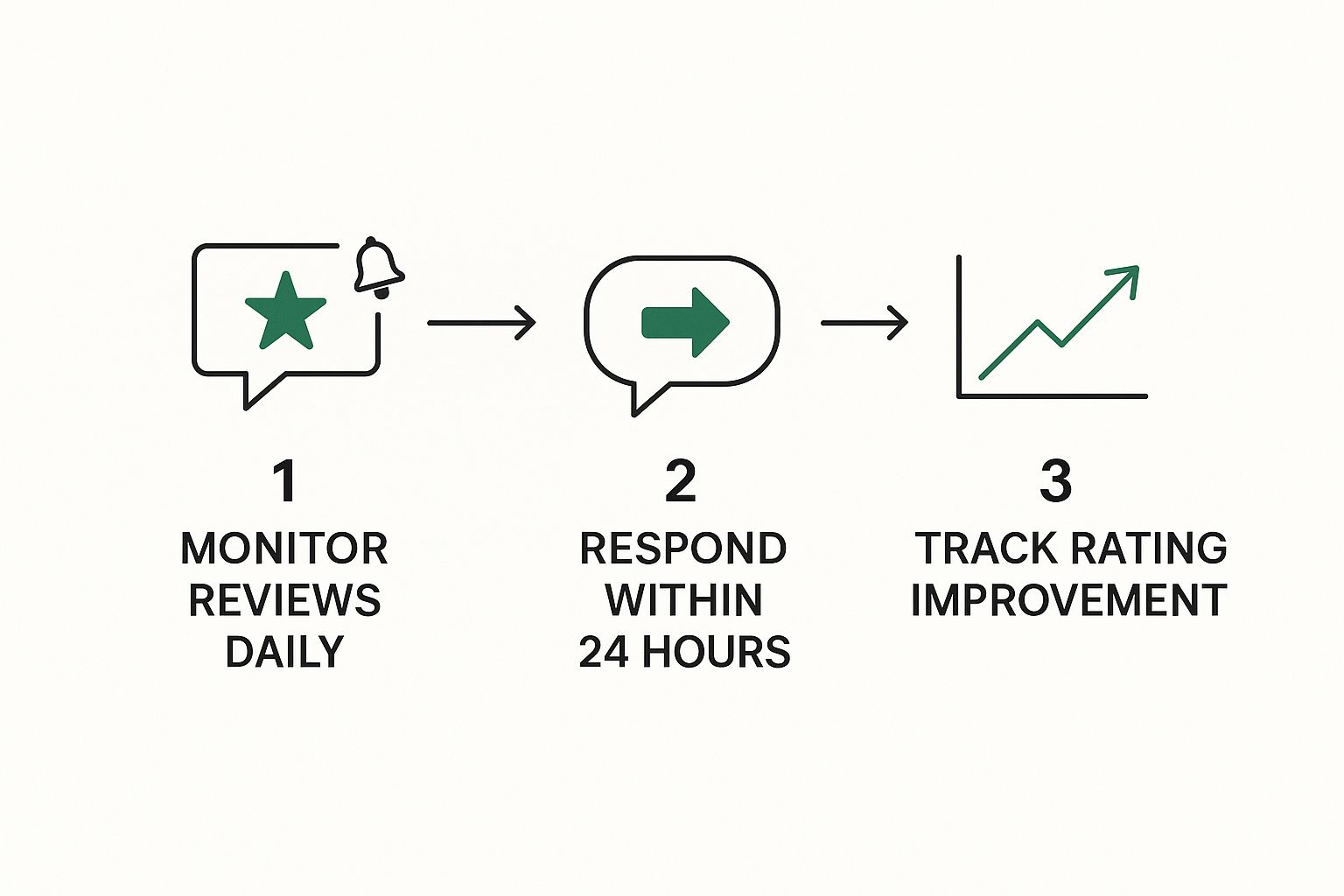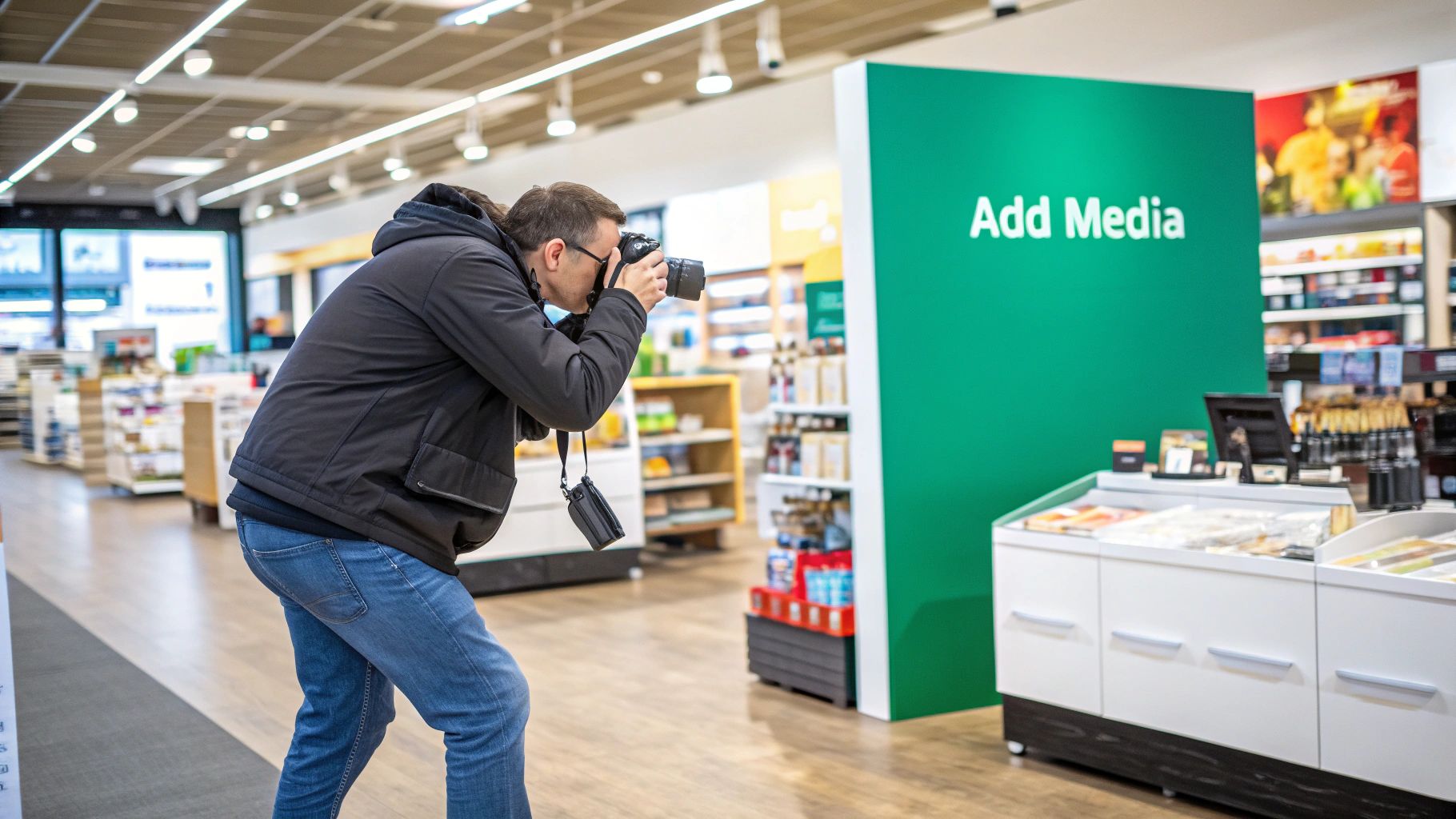Google My Business Optimization for Local Growth
Master Google My Business optimization with our guide. Get actionable strategies to boost your local search ranking, attract customers, and drive growth.
When we talk about Google Business Profile optimization, we're not just talking about filling out a form. It's the ongoing process of fine-tuning your free Business Profile to show up more often and more prominently in local search results—think Google Maps and that coveted "local 3-pack."
This is all about actively managing your listing to make it so compelling and complete that it grabs the attention of local customers. Your goal is to make sure every piece of information is accurate, up-to-date, and genuinely helpful so that a potential customer has every reason to call you first.
Why Your Google Profile Is Your Best Local Marketing Tool

If you run a small local business, whether you're a plumber, a roofer, or run a local cafe, your Google Business Profile is your digital storefront. For most potential customers, it's the very first impression they'll get of your business. Let's be honest, when someone needs a local service right now, their first move is almost always a quick search on their phone.
This is where a polished, well-managed profile stops being a simple listing and starts acting like your best lead-generation machine. It doesn't just display your business name; it gives a potential customer every piece of information they need to make a quick decision and hire you.
The Customer Journey Starts Here
Picture this: a homeowner has a burst pipe and frantically searches "plumber near me." Google's job is to serve up the most relevant and trustworthy options in a split second. Those top results almost always appear in the "local 3-pack," that prime piece of real estate right under the map.
Getting your business into that spot is the number one goal of Google Business Profile optimization. A profile packed with complete details, glowing reviews, and recent photos sends strong signals to Google that you're a credible, active business worth recommending. This visibility directly translates into real-world action for your small business:
- More Phone Calls: Customers can tap a button to call you directly from the search results.
- Website Visits: A link sends interested leads straight to your site to learn more or book a job.
- Direction Requests: People get turn-by-turn navigation right to your shop or service area.
Your Google Business Profile isn’t just about getting found; it’s about building instant trust. When a customer sees a complete profile with great reviews and clear photos of your work, they feel confident choosing you over a competitor with a bare-bones listing.
Turning Clicks into Customers
This whole process is absolutely critical for any service-based local business. As of 2025, a staggering 87% of consumers use Google to evaluate local businesses, making it the undeniable king of local search. Optimizing your profile to land in the local 3-pack massively increases your odds of catching these high-intent customers who are ready to buy.
Ultimately, every single element on your profile helps a potential customer move one step closer to hiring you. The right photos showcase the quality of your work, the Q&A section answers their pressing questions, and your reviews provide the social proof they need to feel confident.
If you're just starting out, our guide on how to get my business on Google Maps will walk you through the initial setup step-by-step.
Getting the Keys to Your Digital Storefront: Claiming and Verifying Your Profile

Before you can even think about optimization, you have to get control of your profile. This is ground zero. It’s the step that unlocks every other tool and gives you the power to shape how your business shows up on Google Search and Maps.
Many small business owners are surprised to find a profile for their company already exists. Google often creates basic listings from public data, or sometimes a customer might have added your business to the map. Your first mission is to find and claim this digital real estate.
First, Find and Claim Your Profile
Just go to Google and search for your business name plus your city. If a profile pops up in the Knowledge Panel on the right or in Maps, scan it for a link that says something like “Own this business?” or “Claim this business.” That’s your way in.
Clicking that link kicks off the ownership process. Google will ask you to confirm a few details to make sure you’re the real owner and not a competitor trying to cause trouble. It’s a simple but vital step for protecting your brand's online identity.
If you search and nothing comes up, no problem. You can easily create a brand-new profile from scratch by heading over to the Google Business Profile manager.
Think of it like claiming a vacant storefront. By verifying your profile, you're not just putting your name on the door; you're getting the keys to renovate, decorate, and turn it into a place that attracts customers.
Once you complete this, you get exclusive access to the dashboard where all the optimization magic happens. Without verification, you're just a bystander, unable to respond to reviews, update your holiday hours, or show off photos from your latest project.
Getting Through the Verification Gauntlet
After you've initiated the claim, Google needs proof that your business is legitimate and physically located where you say it is. This is a crucial security check to weed out fake listings and spam. The verification methods Google offers can vary depending on your business type and history.
The old standby, especially for brand-new profiles, is verification by mail.
Here are the most common ways Google will verify your business:
- Postcard by Mail: This is the classic method. Google mails a postcard with a unique code to your physical business address, which usually shows up in 5-7 business days. It's critical to use a real street address—P.O. boxes won't work and will just slow you down.
- Phone Call or Text: Some businesses will get the option for a quick verification via an automated call or text to the official business phone number.
- Email: This option, when available, sends a code to an official business email address that’s on the same domain as your website (like
[email protected]). - Video Verification: This is becoming more common. You might have to record a short video showing proof of your location (like your storefront sign), your equipment (like your work truck), and proof that you manage the business.
As soon as you get your code, just log back into your profile and enter it. Once you're verified, you have full control. Now you’re ready to turn that bare-bones listing into one of your best local marketing assets.
Filling Out Your Profile to Make a Real Impact
Think of an incomplete Google Business Profile as a physical storefront with a half-painted sign. It sends the wrong message—that you might not be serious, active, or particularly concerned with details. Taking the time to fill out every single field in your profile dashboard is one of the smartest things you can do for your Google My Business optimization. It turns a basic listing into a powerful, persuasive snapshot of your business.
This isn't just busywork. Every piece of information you add helps both potential customers and Google's algorithm figure out exactly what you do, where you do it, and why you're the best local choice. This level of detail is a massive signal Google uses to rank businesses in local search results.
Writing a Business Description That Connects
Your business description is your 750-character elevator pitch. This is your chance to do more than just list services—it's where you connect with people. Use this space to tell your story. What makes your business different? What’s your commitment to quality? Are you a family-owned business with deep roots in the local community?
Make sure to weave in the keywords your customers are actually searching for, but keep it natural. For instance, a landscaper in Austin might talk about their expertise in "sustainable garden design in Austin" or providing "reliable lawn care for Travis County homes." The goal is to sound human, not like a robot stuffing in keywords.
Don't just list what you do—explain why you do it and the value you bring. Instead of saying, "We fix leaky pipes," try something like, "Our family-owned plumbing service offers 24/7 emergency leak repair with a focus on fast, friendly service that respects your home."
That simple shift in tone builds instant trust and helps you stand out. And the data backs this up: a whopping 75% of businesses that rank in the top three local search positions have a complete business description. This detail is crucial, right alongside managing your reputation—many of those top-ranking businesses also have over 200 reviews. You can dig deeper into these optimization statistics to see just how much these details matter.
Choosing the Right Categories and Attributes
Getting your business categories right is non-negotiable for getting found by the right customers. Your primary category is the most important one, as it tells Google what your business is at its core. You need to be as specific as you can. Don't just pick "Contractor"; choose "Kitchen Remodeler" or "Roofing Contractor."
Once your primary category is set, add relevant secondary categories to cast a wider net. That same kitchen remodeler might also offer services as a "Bathroom Remodeler" and "Cabinet Maker." This helps you show up for a broader range of related searches.
From there, it's time to dig into Attributes. These are like little tags that answer quick questions customers have before they even have to ask. They cover things like:
- Accessibility: "Wheelchair accessible entrance"
- Ownership: "Veteran-led" or "Women-owned"
- Offerings: "Free estimates" or "Online appointments"
Every attribute you select acts as a filter, helping the right customers find you while making your profile infinitely more helpful.
Showcasing Your Work with Photos and Services
Let's be honest: visuals sell, especially for a local business. A profile packed with high-quality photos gives customers a genuine look at your work, your team, and your operation. Upload crystal-clear pictures of finished projects, your crew on the job, or your branded vehicles out in the community. Try to add new photos regularly—it's a great signal to Google that your business is active and thriving.
Finally, take the time to build out your Products and Services sections. Don't just list a service like "Lawn Mowing." Flesh it out with a detailed description and maybe even a price range. For example: "Weekly Residential Lawn Mowing - Includes mowing, edging, and blowing off of all hard surfaces. Starting at $50 for standard lots." This kind of detail answers questions upfront, builds confidence, and gives customers every reason to take the next step and get in touch.
As this visual guide on customer interactions shows, once your profile is set up, responding to customers is the next critical piece of the puzzle.

This simple infographic perfectly illustrates the powerful loop you want to create: monitor your reviews, respond to them quickly, and watch your reputation—and your rankings—grow as a direct result.
To help you keep track of all these moving parts, I've put together a quick checklist. Use it to make sure you've squeezed every bit of value out of each section of your profile.
Google Business Profile Section Optimization Checklist
| Profile Section | Optimization Action | Why It Matters for Your Business |
|---|---|---|
| Business Name | Ensure it's your exact, real-world business name. No extra keywords. | Builds trust and avoids violating Google's guidelines, which can lead to suspension. |
| Primary Category | Choose the most specific category that defines your core business. | This is the single most important ranking factor for your profile's relevance. |
| Secondary Categories | Add all other relevant categories that describe your services. | Helps you appear for a wider range of related, non-primary search queries. |
| Business Description | Write a compelling, 750-character summary. Include keywords naturally. | Your chance to connect with customers, explain your value, and set yourself apart. |
| Service Area | If you travel to customers, define your specific service areas by city or ZIP code. | Tells Google exactly where you operate, ensuring you appear in the right local searches. |
| Hours of Operation | List accurate hours, including special hours for holidays. | Prevents customer frustration and negative reviews from showing up to a closed business. |
| Photos & Videos | Regularly upload high-quality images of your work, team, and location. | Visuals dramatically increase engagement and provide proof of your quality work. |
| Services/Products | Add detailed descriptions and prices for each of your offerings. | Answers customer questions upfront and helps Google understand your business in depth. |
| Attributes | Select all applicable attributes (e.g., Women-owned, Free estimates). | Acts as a filter to help highly-qualified customers find you based on their specific needs. |
| Q&A Section | Proactively ask and answer common questions about your business. | Provides helpful information instantly and allows you to control the narrative. |
Completing this checklist is more than just a setup task; it's an ongoing process. A fully optimized profile is a living asset for your business, consistently attracting new customers and reinforcing your reputation in the local community.
Engaging Customers Through Reviews, Posts, and Q&A

Having a fully filled-out profile is just the beginning. The real magic for your local visibility happens with consistent, ongoing activity. You have to stop thinking of your Google Business Profile as a static listing and start treating it like a dynamic conversation hub with your community.
This is where you build real trust, show potential customers you’re open and active, and send all the right signals to Google that your business is relevant.
The three best tools you have for this are customer reviews, Google Posts, and the often-overlooked Questions & Answers section. Getting a handle on these is a core part of any smart Google My Business optimization strategy because they get your community involved and put your responsiveness on display.
Fuel Your Profile with Customer Reviews
Reviews are the lifeblood of any local business profile. It's not just an opinion; Google itself says that positive reviews are a major local ranking factor. They provide that critical social proof people look for before they even think about picking up the phone.
A steady stream of fresh reviews tells both customers and Google that your business is alive, well, and valued by the community. But I get it—asking for reviews can feel awkward. The trick is to make it incredibly simple for your happy clients.
- Ask at the right moment. The best time is right after you’ve finished a job and your customer is beaming about the results. That's peak happiness.
- Give them a direct link. You can use a free online tool to generate a link that takes them straight to the review form. Text or email it over so there's zero friction.
- Never offer incentives. This is a big one. It's against Google's rules to offer discounts or freebies for reviews. A simple, polite request is all you need.
Responding to every single review—the good and the bad—is just as crucial. When you take the time to write a thoughtful response, you're showing everyone who reads it that you care about customer feedback. It’s a simple act that builds a massive amount of trust. If you want to dive deeper, we've got a whole guide on how to get more Google reviews.
Use Google Posts to Share Timely Updates
Think of Google Posts as free mini-ads that show up right on your Business Profile in search results. This feature is absolutely perfect for sharing timely updates and grabbing a customer's attention. You can highlight special offers, showcase photos from a recent job, or share company news.
I tell my small business clients to think of Google Posts as their business's social media feed, but one that lives directly on Google. It’s the perfect place for a landscaper to announce a "Fall Cleanup Special" or for a contractor to share stunning before-and-after photos of a kitchen remodel.
To really make this work for you, try to publish a new post at least once a week. That consistent activity is a great signal to Google. Always include a high-quality photo and a clear call-to-action (CTA) like "Call Now" or "Book Online." Keep in mind that many post types expire after seven days, so regular updates are key to keeping your profile looking fresh.
Control the Narrative with Q&A
The Questions & Answers section is a hidden gem. So many business owners ignore it, but it can be an incredibly powerful tool. Here's the catch: anyone can ask a question on your profile, and anyone can answer it. If you're not paying attention, you could end up with a wrong answer from a random user sitting at the top of your profile.
The best strategy here is to get out ahead of it. You can—and absolutely should—ask and answer your own questions. Just make a list of the most common questions you get from customers and post them to your profile yourself.
- What's your service area?
- Do you offer free estimates?
- What are your payment options?
- Are you licensed and insured?
By pre-populating this section with your own FAQs, you provide instant value to potential customers and take control of the information they see first. It’s a simple but incredibly effective way to manage your online reputation and make it easier for people to decide to hire you.
Advanced Strategies to Outrank Local Competitors
Once you've filled out your profile and started interacting with customers, it's time to get a real competitive edge. So many business owners check the boxes and then stop. But the advanced stuff? That's what separates a decent profile from one that completely dominates the local map pack. These are the tactics that send powerful trust signals to Google.
One of the most potent, yet frequently botched, signals is NAP consistency. That stands for your business Name, Address, and Phone number. Think of it this way: Google is constantly crawling the web, looking at your info on directories like Yelp, checking your social media pages, and of course, your own website. When your NAP is identical everywhere, it's like a dozen reliable sources vouching for you, confirming your business is exactly who and where you say you are.
Even tiny inconsistencies can muddy the waters and drag down your ranking. We're talking about things as small as using "St." on your profile but "Street" on your website, or "(555)" on one directory and "555-" on another. It's tedious, but taking the time to audit your online footprint and standardize every single mention is a huge win.
Harnessing Performance Insights
Your Google Business Profile dashboard has a hidden gem: the "Performance" tab. This is where you stop guessing and start knowing. Instead of wondering how people are finding you, the data lays it all out, showing you the exact search terms customers used to land on your profile.
This is where you can get surgical with your strategy. For example:
- Discover new keywords: A landscaper might see people are searching for "drought-tolerant garden design." Boom. That's a perfect topic for a new Google Post or a service to highlight on your profile.
- Understand customer actions: The report shows you exactly how many people called you, clicked to your website, or requested directions straight from your listing.
By checking these insights regularly, you can double down on what's clearly working. If you notice a big spike in calls right after you upload photos from that big patio project, you have your proof—that's the kind of content your audience wants to see.
This data-first approach is crucial for staying on top, especially with how quickly Google changes things. We're already seeing hints of stricter verification processes and a heavy reliance on well-structured profile data to feed its generative AI answers. According to a recent report on the evolving state of Google Business Profiles, businesses with thin or outdated info are at a higher risk of suspension, making this kind of maintenance more important than ever.
Ultimately, a detailed and accurate profile isn't just about winning today's search results; it’s about future-proofing your business. When you master these advanced strategies, you’re setting yourself up to own the local market now and be ready for whatever comes next. The insights you pull are especially powerful for service businesses, a concept we explore further in our guide on local SEO for landscapers.
Got Questions About Your Google Business Profile?
You're not alone. When you're trying to master your Google Business Profile, questions are bound to pop up, especially when you're running a busy local service business. Getting the right answers means you can stop guessing and start focusing on what actually brings in more customers.
Let's dive into some of the most common questions we hear from tradespeople and local business owners.
How Long Until I See Results from Optimization?
This is the big one, and the honest answer is: it depends.
Some changes, like updating your phone number or business hours, show up almost immediately. But the results you really want—like ranking higher in local search and getting more calls—take a bit more time to kick in.
Generally, you should start seeing a real jump in calls, website visits, and overall visibility within a few weeks to a couple of months. The key is consistency. Every time you add a new post, get a fresh review, or upload a photo, you're sending a positive signal to Google. Stick with it, and you'll see the payoff.
What’s the Single Biggest Mistake Business Owners Make?
Without a doubt, it's the "set it and forget it" mindset. Too many business owners go through the initial steps of claiming their profile, filling in the basics, and then never look at it again. This is a huge missed opportunity.
The biggest mistake is treating your Google Business Profile like a static directory listing instead of the dynamic marketing tool it is. A neglected profile with outdated info and unanswered questions is a goldmine for your competitors.
Google's algorithm loves activity. When you stop responding to reviews, stop adding Google Posts, or let your Q&A section go stale, your rankings will suffer. An active profile tells both Google and your customers that you're open, engaged, and ready to help.
I Run My Business from Home. Do I Have to Show My Address?
Absolutely not. This is a major concern for plumbers, electricians, landscapers, and any service pro who doesn't have a public storefront. Thankfully, Google has this figured out.
When you set up your profile, you can classify your business as a "Service-Area Business." This option lets you hide your physical address and instead show customers a map of the areas you serve, whether it's specific towns, zip codes, or entire counties.
You'll still need to provide a real address to Google for verification mail, but it will not be shown to the public. This is the perfect way to get found in local searches for your service area while keeping your home address private.
Ready to turn your online presence into a customer-generating machine? The team at SiteStarter specializes in creating high-quality websites and optimizing Google Business Profiles for tradesmen just like you. We handle all the technical details so you can focus on what you do best. Get found on Google and land more jobs with SiteStarter.